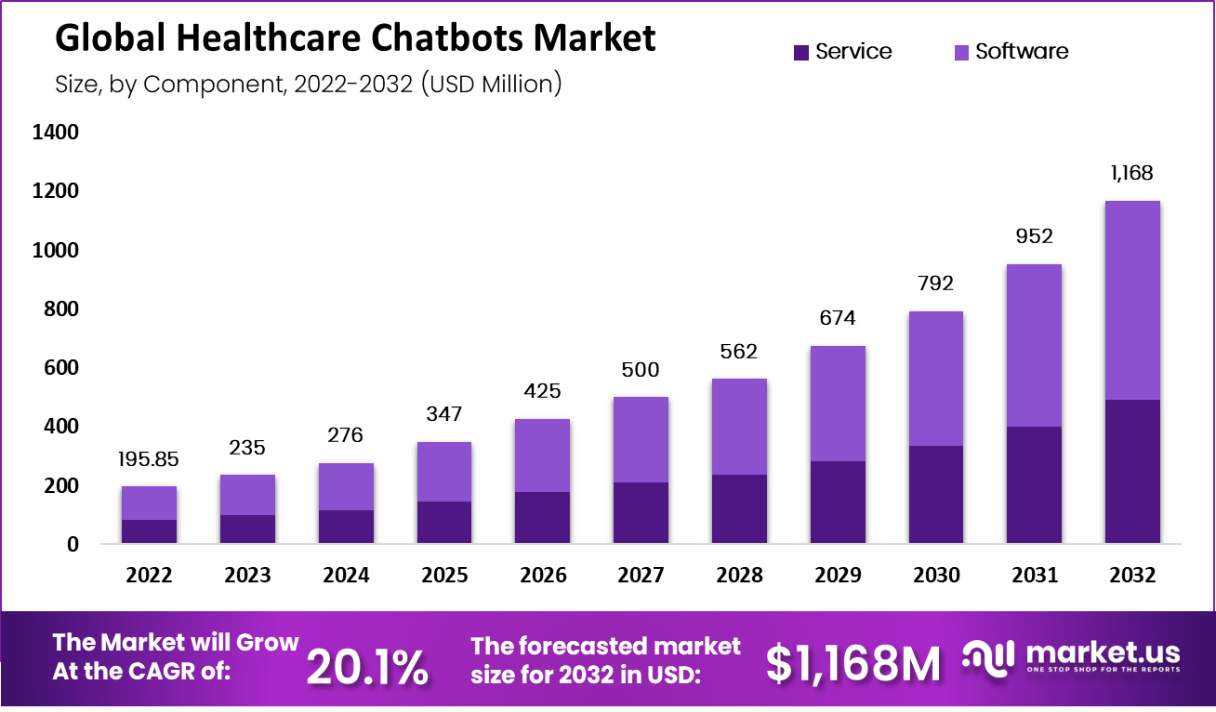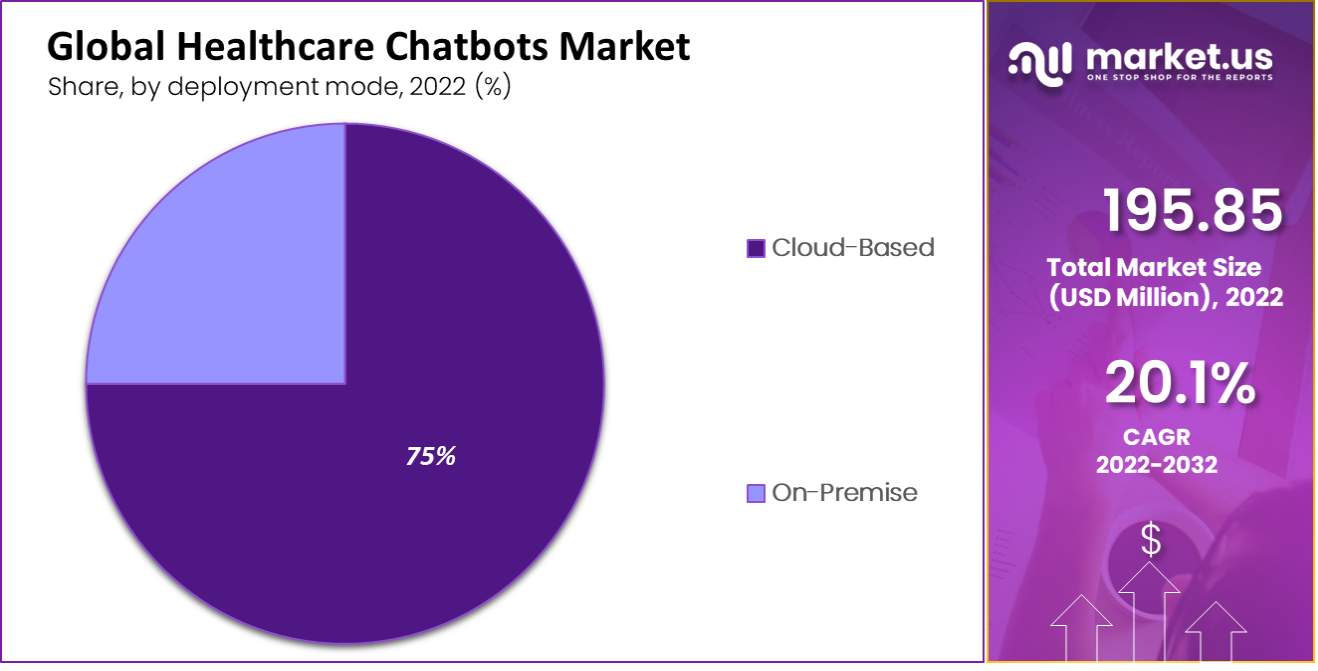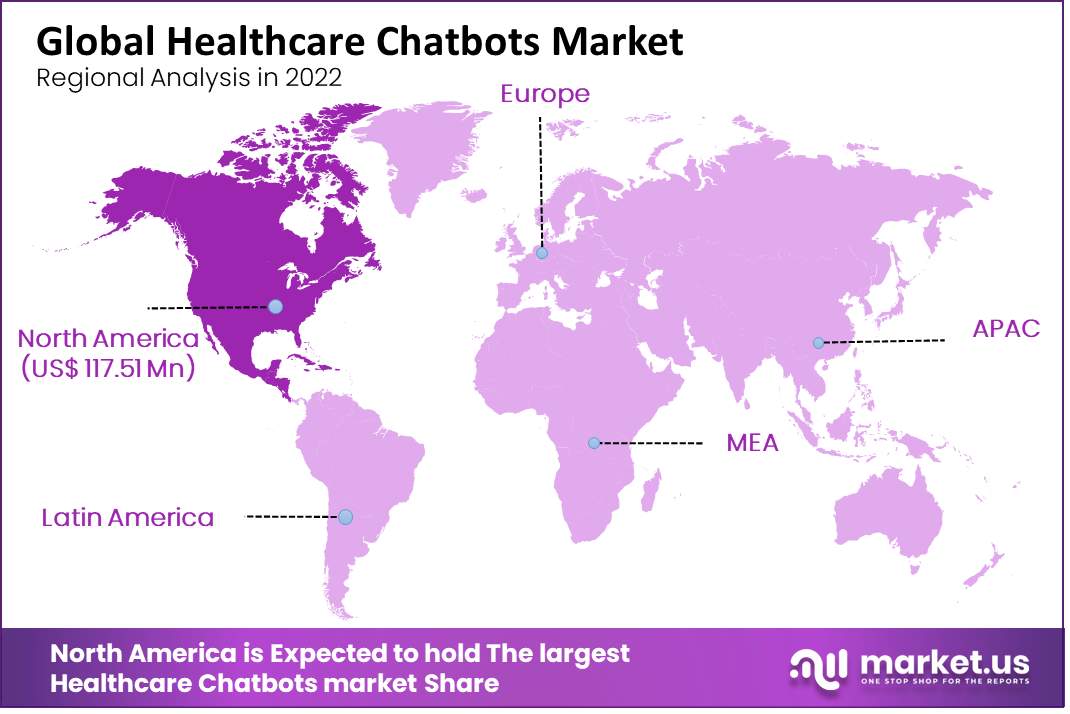Global Healthcare Chatbots Market By Component (Service, and Software), By Deployment Mode (On-Premise, and Cloud-Based), By Application, By End Users, By Region and Companies - Industry Segment Outlook, Market Assessment, Competition Scenario, Trends, and Forecast 2023-2032
- Published date: Oct 2023
- Report ID: 101331
- Number of Pages: 395
- Format:
- keyboard_arrow_up
Quick Navigation
Report Overview
In 2022, the Global Healthcare Chatbots market size was valued at USD 195.85 Million and is expected to reach USD 1168 Million in 2032. This market is estimated to register a CAGR of 20.1% between 2023 and 2032.
Chatbots are computer software created to mimic communication with human users, particularly online. It assists users in a variety of fields. The companies creating chatbot applications for doctors and patients in the healthcare sector have found it appealing.

*Actual Numbers Might Vary In The Final Report
The growing implementation of healthcare chatbots, the increasing demand for healthcare chatbots as a result of the growing need for online health assistance, and the growing number of collaborations between key industry players and healthcare providers are all contributing factors to the market’s expansion. Other factors include an increase in patient waiting times and ineffective patient engagement.
Key Takeaways
- Market Size: The global Healthcare Chatbots market was valued at USD 195.85 million in 2022 and is expected to reach USD 1,168 million by 2032, with a projected CAGR of 20.1% from 2023 to 2032.
- Chatbot Definition: Healthcare chatbots are computer software designed to mimic human communication, aiding users, particularly in the healthcare sector, with services ranging from symptom checking to medical assistance.
- Driving Factors:
- Increasing demand for virtual healthcare due to telemedicine adoption.
- Rising prevalence of chronic diseases, leading to personalized patient assistance.
- Advances in artificial intelligence (AI) and natural language processing (NLP) technologies.
- Cost-effective solutions that reduce the workload of healthcare professionals.
- Restraining Factors:
- Lack of patient trust in chatbot accuracy and reliability.
- Privacy and security concerns related to sensitive patient data.
- COVID-19 Impact: The pandemic accelerated the adoption of healthcare chatbots, providing 24/7 access to COVID-19 information and supporting mental health during the crisis.
- Component Analysis: Software segment dominates with a projected CAGR of 20.1%, contributing to 58% of the market in 2022.
- Deployment Mode Analysis: Cloud-based models hold the majority share, accounting for nearly 75% in 2022.
- Application Analysis:
- Symptom-checking applications have a higher market share.
- Appointment scheduling and medical guidance applications are expected to grow rapidly.
- End-User Analysis: Patients are the primary users of healthcare chatbots, with ease of access and prompt grievance handling as key drivers.
- Regional Analysis: North America holds the largest market share (60%), while Europe is projected to register a CAGR of 20.1% by 2032. The Asia-Pacific region is the fastest-growing market for healthcare chatbots.
- Key Players Analysis: Major players include Your MD, PACT Care BV, Woebot Labs, Sensely Inc., Ada Digital Health Ltd, Health Tap Inc., Infermedica, Babylon Health, and COM Inc., among others.
- Growth Opportunity: The market is driven by advancements in AI technology, increased use of chatbots by healthcare organizations, and the growing demand for automation in healthcare services.
- Latest Trends: Key trends include the rise of virtual healthcare, AI advancements, focus on patient engagement, and increased usage of chatbots in mental health support.
- Europe’s Market: Europe’s healthcare chatbot market is projected to be valued at USD 37.01 million in 2032, with a revenue share of 18.9%.
- Asia-Pacific: The Asia-Pacific region is the fastest-growing market for healthcare chatbots, with countries like China and India making significant contributions.
Driving Factors
Increasing demand for virtual healthcare
With the increasing adoption of telemedicine and virtual healthcare, healthcare chatbots are becoming more popular. Chatbots are being used to provide 24/7 assistance to patients, allowing healthcare professionals to focus on more critical tasks.
Rising prevalence of chronic diseases
The increasing prevalence of chronic diseases, such as diabetes and hypertension, is driving the demand for healthcare chatbots. Chatbots can help patients manage their conditions by providing personalized advice and reminders about medications.
Advances in artificial intelligence (AI) and natural language processing (NLP):
The development of advanced AI and NLP technologies has enabled chatbots to understand and respond to natural language, making them more effective in assisting patients.
Cost-effective healthcare solutions
Chatbots are cost-effective solutions for healthcare providers, as they can reduce the workload of healthcare professionals and improve efficiency.
Restraining Factors
Lack of trust
One of the major restraints in the healthcare chatbot market is the lack of trust among patients. Many patients are skeptical about the accuracy and reliability of chatbots, particularly when it comes to health-related issues. This lack of trust may limit the adoption and use of healthcare chatbots.
Privacy and security concerns
Healthcare chatbots often collect and process sensitive patient data. As a result, privacy and security concerns can act as a major restraint on the growth of the healthcare chatbot market.
By Component Analysis
The software segment is the most lucrative in the global healthcare chatbot market.
Based on components, the market for healthcare chatbots market is segmented into service and software. Among these types, the software segment is the most lucrative in the global healthcare chatbots market, with a projected CAGR of 20.1%. The total revenue share software component market is 58% in 2022. The revenue from chatbot solutions, designing, & programming is also included in the healthcare chatbots market for software, however consulting, installation, system integration, support, and maintenance are not included.
The majority of chatbot service providers provide a freemium option that may be upgraded to a monthly or yearly plan, and they frequently depend on subscription-based pricing models to make money. The market for chatbot software is growing as a result of more people using smartphones and a better grasp of self-monitoring techniques for managing treatment and diagnoses.
By Deployment Mode Analysis
The Cloud-based model sector had the highest share.
By deployment mode, the market is further divided into on-premise and cloud-based modes. Due to the numerous benefits of various chatbots, the loud-based model sector had the highest share of almost 75% in 2022 and experienced the fastest growth during the anticipated time. Cloud-based chatbots are simpler to utilize and require less adjustment than on-premise chatbots. Consequently, the aforementioned elements encourage the growth of the market for healthcare chatbots.

By Application Analysis
The market share of symptom check applications was higher.
Based on the applications the market is divided into symptom checking & medical assistance, and appointment scheduling & medical guidance. The market share of symptom check applications was higher. The demand for such solutions is being driven by rising smartphone and internet utilization among patients and healthcare professionals. Appointment scheduling and monitoring are expected to grow at the quickest rate throughout the forecasted period due to the need to decrease client wait times and properly utilize healthcare resources. The most popular primary care symptom checker chatbots are Your. Doctor, Babylon Health, Ada, and Buoy Health.
By End-User Analysis
Patients are the major users of healthcare chatbots.
Based on end-users, the market is segmented into patients, healthcare providers, insurance companies, and other end-users. Among these end-users, patients are the major users of healthcare chatbots. One of the forces behind innovation is how simple it is to seek professional help. Also, prompt handling of patient grievances and clear solutions to many problems promote patient acceptance.
Key Market Segments
Based on Component
- Service
- Software
Based on Deployment Mode
- On-Premise
- Cloud-Based
Based on Application
- Symptom Checking & Medication Assistance
- Appointment Scheduling & Medical Guidance
Based on End-User
- Patients
- Healthcare Providers
- Insurance Companies
- Other End-Users
Growth Opportunity
The development of artificial intelligence in technology is driving the market for healthcare chatbots to grow.
The vast advancements in artificial intelligence are the main reason why the market for healthcare chatbots is growing on a global scale. This is mostly due to the implementation of increasingly sophisticated chatbot systems, which are highly intelligent to cope with interacting with clients who want to use healthcare services. As the demand for automation in the healthcare industry increases, chatbot usage is growing as a means of achieving online efficacy in resolving consumer inquiries and customer retention. Soon, a highly encouraging growth curve is anticipated for healthcare chatbots. The extensive use of chatbot services by many healthcare organizations has increased the range of their capabilities and competencies.
A sizable clientele that needs the help of technologies like chatbot services has been developed as a result of the use of AI in consumer gadgets connected to maintaining health. Numerous healthcare businesses have been utilizing various digital marketing methods as a result of recent major advancements in digital technology. These techniques are applicable to chatbot technology’s voice and messaging services. As a result, in the coming years, the market for healthcare chatbots will grow.
Latest Trends
The global healthcare chatbot market has seen significant growth in recent years, and this trend is expected to continue in the coming years.
Rising demand for virtual healthcare
The COVID-19 pandemic has accelerated the adoption of virtual healthcare services, including chatbots. Chatbots are being used to provide patients with 24/7 access to healthcare information and support, without the need for face-to-face consultations.
Advancements in artificial intelligence (AI)
Healthcare chatbots are powered by AI and natural language processing (NLP) technologies, which are becoming increasingly sophisticated. This allows chatbots to understand patients’ queries more accurately and provide more personalized responses.
Increased focus on patient engagement
Healthcare providers are increasingly using chatbots to improve patient engagement and provide a more seamless healthcare experience. Chatbots can be used to remind patients about medication schedules, provide information about health conditions, and answer questions about treatment options.
Growing adoption of chatbots in mental health
There has been a significant increase in the use of chatbots to provide mental health support. Chatbots can provide emotional support and offer coping strategies for a range of mental health conditions, including anxiety and depression.
Regional Analysis
North America is estimated to be the most lucrative market in the global healthcare chatbots market, with the largest market share of 60%, and is expected to register a CAGR of 19.8% during the forecast period. However, Europe’s healthcare chatbot market is projected to be valued at USD 37.01 Mn, with a revenue share of 18.9% in 2032, and register a CAGR of 20.1% from 2022 to 2032.

The growth of this market is driven by the increasing demand for virtual healthcare services, the presence of a large number of key players, and high levels of investment in research and development. In addition, the rising incidence of chronic diseases and the increasing demand for patient engagement solutions are also contributing to the growth of the healthcare chatbot market in this region.
The Asia-Pacific region is expected to be the fastest-growing market for healthcare chatbots due to the increasing adoption of digital technologies in the healthcare sector, the rising prevalence of chronic diseases, and the growing need for cost-effective solutions to improve patient outcomes. Countries such as China and India are expected to be major contributors to the growth of the healthcare chatbot market in this region.
Key Regions and Countries
- North America
- The US
- Canada
- Mexico
- Western Europe
- Germany
- France
- The UK
- Spain
- Italy
- Portugal
- Ireland
- Austria
- Switzerland
- Benelux
- Nordic
- Rest of Western Europe
- Eastern Europe
- Russia
- Poland
- The Czech Republic
- Greece
- Rest of Eastern Europe
- APAC
- China
- Japan
- South Korea
- India
- Australia & New Zealand
- Indonesia
- Malaysia
- Philippines
- Singapore
- Thailand
- Vietnam
- Rest of APAC
- Latin America
- Brazil
- Colombia
- Chile
- Argentina
- Costa Rica
- Rest of Latin America
- Middle East & Africa
- Algeria
- Egypt
- Israel
- Kuwait
- Nigeria
- Saudi Arabia
- South Africa
- Turkey
- United Arab Emirates
- Rest of MEA
Key Players Analysis
Emerging key players are focused on a variety of strategic policies to develop their respective businesses in foreign markets. Several healthcare chatbots market companies are concentrating on expanding their existing operations and R&D facilities. Furthermore, businesses in the healthcare chatbots market are developing new services. In addition, several key players are now focusing on different marketing strategies such as spreading awareness about healthcare chatbots, which is boosting the target products’ growth. Listed below are some of the most prominent healthcare chatbot industry players.
Key Players
- Your MD
- PACT Care BV
- Woebot Labs
- Sensely Inc
- Ada Digital Health Ltd
- Health Tap Inc
- Infermedica
- Babylon Health
- COM Inc
- Buoy Health Inc
- Other Key Players
Recent Developments
- In March 2022: In partnership with the non-profit Girl Impact, WhatsApp launched a new education programs chatbot specifically designed for young women in India. The chatbot is called Bol Behen, which corresponds to Speak Sister. It is powered by artificial intelligence (AI). The purpose of this effort is to assist young women and girls who may have concerns about their physical health and sexual well-being.
- In March 2022:ai released Genie, a soul chatbot system that enables businesses to swiftly create interactive chatbots that can distinguish between different types of material.
Report Scope
Report Features Description Market Value (2022) USD 195.85 Million Forecast Revenue (2032) USD 1,168 Million CAGR (2023-2032) 20.1% Base Year for Estimation 2022 Historic Period 2016-2021 Forecast Period 2023-2032 Report Coverage Revenue Forecast, Market Dynamics, Competitive Landscape, Recent Developments Segments Covered By Component- Service, and Software; By Deployment Mode- On-Premise, and Cloud-Based; By Application- Symptom Checking & Medication Assistance, and Appointment Scheduling & Medical Guidance; By End-User- Patients, Healthcare Providers, Insurance Companies, Other End-Users Regional Analysis North America – The US, Canada, & Mexico; Western Europe – Germany, France, The UK, Spain, Italy, Portugal, Ireland, Austria, Switzerland, Benelux, Nordic, & Rest of Western Europe; Eastern Europe – Russia, Poland, The Czech Republic, Greece, & Rest of Eastern Europe; APAC – China, Japan, South Korea, India, Australia & New Zealand, Indonesia, Malaysia, Philippines, Singapore, Thailand, Vietnam, & Rest of APAC; Latin America – Brazil, Colombia, Chile, Argentina, Costa Rica, & Rest of Latin America; Middle East & Africa – Algeria, Egypt, Israel, Kuwait, Nigeria, Saudi Arabia, South Africa, Turkey, United Arab Emirates, & Rest of MEA Competitive Landscape Your MD, PACT Care BV, Woebot Labs, Sensely Inc, Ada Digital Health Ltd, HealthTap Inc, Infermedica, Babylon Health, COM Inc, Buoy Health Inc, Other Key Players Customization Scope Customization for segments, region/country-level will be provided. Moreover, additional customization can be done based on the requirements. Purchase Options We have three licenses to opt for: Single User License, Multi-User License (Up to 5 Users), Corporate Use License (Unlimited User and Printable PDF) Frequently Asked Questions (FAQ)
What will be the market size for Healthcare Chatbots Market in 2032?In 2032, the Healthcare Chatbots Market will reach USD 1168 million.
What CAGR is projected for the Healthcare Chatbots Market?The Healthcare Chatbots Market is expected to grow at 20.1% CAGR (2023-2032).
List the segments encompassed in this report on the Healthcare Chatbots Market?Market.US has segmented the Healthcare Chatbots Market Market by geographic (North America, Europe, APAC, South America, and MEA). By Component, market has been segmented into Service and Software. By Deployment Mode, the market has been further divided into On-Premise and Cloud-Based.
Which segment dominate the Healthcare Chatbots industry?With respect to the Healthcare Chatbots industry, vendors can expect to leverage greater prospective business opportunities through the Software segment, as this dominate this industry.
Name the major industry players in the Healthcare Chatbots Market.Your MD, PACT Care BV, Woebot Labs, Sensely Inc, Ada Digital Health Ltd and Other Key Players are the main vendors in this market.

- Your MD
- PACT Care BV
- Woebot Labs
- Sensely Inc
- Ada Digital Health Ltd
- Health Tap Inc
- Infermedica
- Babylon Health
- COM Inc
- Buoy Health Inc
- Other Key Players
- settingsSettings
Our Clients
| Single User $4,599 $3,499 USD / per unit save 24% | Multi User $5,999 $4,299 USD / per unit save 28% | Corporate User $7,299 $4,999 USD / per unit save 32% | |
|---|---|---|---|
| e-Access | |||
| Report Library Access | |||
| Data Set (Excel) | |||
| Company Profile Library Access | |||
| Interactive Dashboard | |||
| Free Custumization | No | up to 10 hrs work | up to 30 hrs work |
| Accessibility | 1 User | 2-5 User | Unlimited |
| Analyst Support | up to 20 hrs | up to 40 hrs | up to 50 hrs |
| Benefit | Up to 20% off on next purchase | Up to 25% off on next purchase | Up to 30% off on next purchase |
| Buy Now ($ 3,499) | Buy Now ($ 4,299) | Buy Now ($ 4,999) |












